
Early American Needlework Samplers
- Their genealogical value to researchers today
as well as a look into the lives of these young sampler makers
whose talent, skill and craft we are still witnesses of today.

A very typical needlework sampler commonly made by young girls in the in the late 1700's and early 1800's in American
"SAMPLER"
- Definition:
A needlework sampler is a
piece of embroidery or cross-stitching produced as a 'specimen
of achievement', demonstration or a test of skill in needlework.
It often includes the alphabet, figures, motifs, decorative
borders and sometimes the name of the person who embroidered
it and the date. The word sampler is derived from the Latin
exemplum, which means 'example'. Samplers were created by young girls
of the 18th and 19th century, popularly here in early America as well as
England and was part of their early education into household and family duties.
<< Watch this incredible video containing some beautiful examples of samplers & family registers >>
.
piece of embroidery or cross-stitching produced as a 'specimen
of achievement', demonstration or a test of skill in needlework.
It often includes the alphabet, figures, motifs, decorative
borders and sometimes the name of the person who embroidered
it and the date. The word sampler is derived from the Latin
exemplum, which means 'example'. Samplers were created by young girls
of the 18th and 19th century, popularly here in early America as well as
England and was part of their early education into household and family duties.
<< Watch this incredible video containing some beautiful examples of samplers & family registers >>
.
The earliest known American sampler was made by Loara Standish of the Plymouth Colony about 1645. By the 1700s, samplers depicting alphabets and numerals were worked by young women to learn the basic needlework skills needed to operate the family household. By the late 1700s and early 1800s, schools or academies for well-to-do young women flourished, and more elaborate pieces with decorative motifs such as verses, flowers, houses, religious, pastoral, and/or mourning scenes were being stitched. The parents of these young women proudly displayed their embroideries as showpieces of their work, talent, and status.
In recent years, samplers have become important in museum collections as representations of early American female education. Many are signed, and some are inscribed with locations and the names of teachers and schools. The emergence of large numbers of these samplers has resulted in much research in diaries, account books, letters, newspaper ads, local histories, and published commentary that is helping to illuminate the lives of women in early America.
In eighteenth-century America, a girl was expected to grow up, get married, have children, and take care of a home. Because of the limits of her sphere, a girl received a very different education from that available to a boy. Indeed, before the advent of public education in the mid-nineteenth century, in order to receive any education at all a boy or a girl had to be born into the middle or upper classes and have parents who valued education enough to pay for it. Usually, a boy would be taught traditional academic subjects, while a girl might be tutored in the barest rudiments of reading and arithmetic. Instead of academic studies, girls were usually sent to schools that taught an assortment of skills considered “female accomplishments”—music, watercolor painting, comportment, manners, and sewing.
As part of her preparation for the responsibility of sewing clothes and linens for her future family, most girls completed at least two samplers. The first, which might be undertaken when a girl was as young as five or six, was called a marking sampler. Marking samplers served a dual purpose: they taught a child basic embroidery techniques and the alphabet and numbers. The letters and numbers learned while embroidering a marking sampler were especially useful, since it was important that any homemaker keep track of her linens, some of her most valuable household goods. This was accomplished by marking them, usually in a cross stitch, with her initials and a number.
Young girls made marking samplers either at home under the tutelage of their mother or grandmother, or at small community schools, called “dame schools” for the women—usually widows or spinsters—who ran them. The equivalent of today’s early years of elementary school, they were attended by both boys and girls. The children were taught reading and arithmetic, and in some cases both sexes participated in knitting, sewing, and sampler-making instruction. Although boys usually went on for further academic training, in many cases this was the only formal schooling a girl received.
A girl who was lucky enough to continue her education usually made a second embroidery at a ladies boarding school while she was in her adolescent years. This was usually a more decorative pictorial sampler or needlework picture While less straightforwardly useful than marking samplers, decorative samplers and needlework pictures also served an important function: they revealed the values of the girl and her family to potential suitors. The completed work was usually framed and hung in the parlor, proclaiming the maker’s obedience, patience, and skill. It also communicated that a girl’s parents were wealthy enough to send their daughter to school and that the family valued the arts of refinement. The verses found on many samplers reinforced these messages, emphasizing the importance of female virtue, the value of education, and obedience to one’s parents and to God. The acceptance of death and the remembrance of the dead, including the sampler maker herself, is another frequent theme. Girls usually signed their samplers, stitching their name, age, and the date the sampler was completed. These small bits of embroidered cloth are often all that remains to testify to the otherwise unrecorded lives of their makers.
Although most women did not make decorative embroideries after they married and became responsible for all the day-to-day sewing that was needed to keep their families clothed and provided with basic linens, some continued to make imaginatively patterned and colored embroidered textiles for their homes. The most common projects, especially in New England, were bedcoverings and bedhangings. These were usually sewn of a linen or linen/cotton blend fabric that was decoratively stitched with patterns of plants, flowers, and birds in brightly colored worsted wool. These designs imitated similar bedcoverings and hangings popular in England; the English embroideries looked to elaborately printed textiles from India for inspiration.
Another, much more rarely surviving example of household embroidery was upholstery covers for seating furniture; the Museum owns one completely embroidery-covered easy chair and an embroidered chair back. Projects like bedcovers or furniture upholstery could have been made by teenage girls who were preparing to be married, or by married women who were wealthy enough to have servants to complete household chores, thereby allowing them the leisure time in which to embroider. But in some cases, embroidered household textiles were actually “professionally made”: during the eighteenth century, talented embroiderers are known to have sewn for their neighbors in exchange for money or goods.
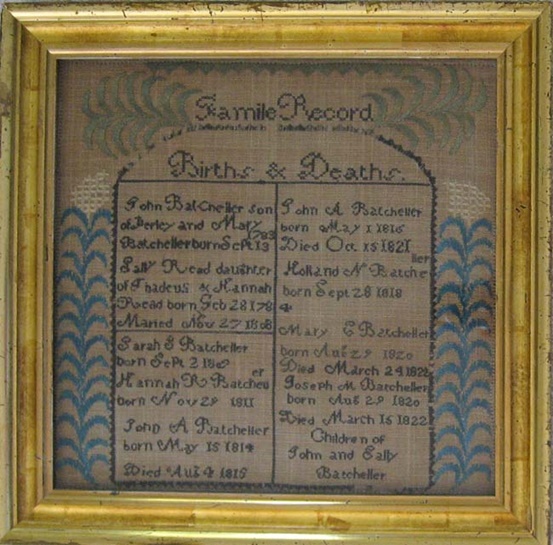 .
.Such valuable information has often been overlooked by geneaogist and family researchers
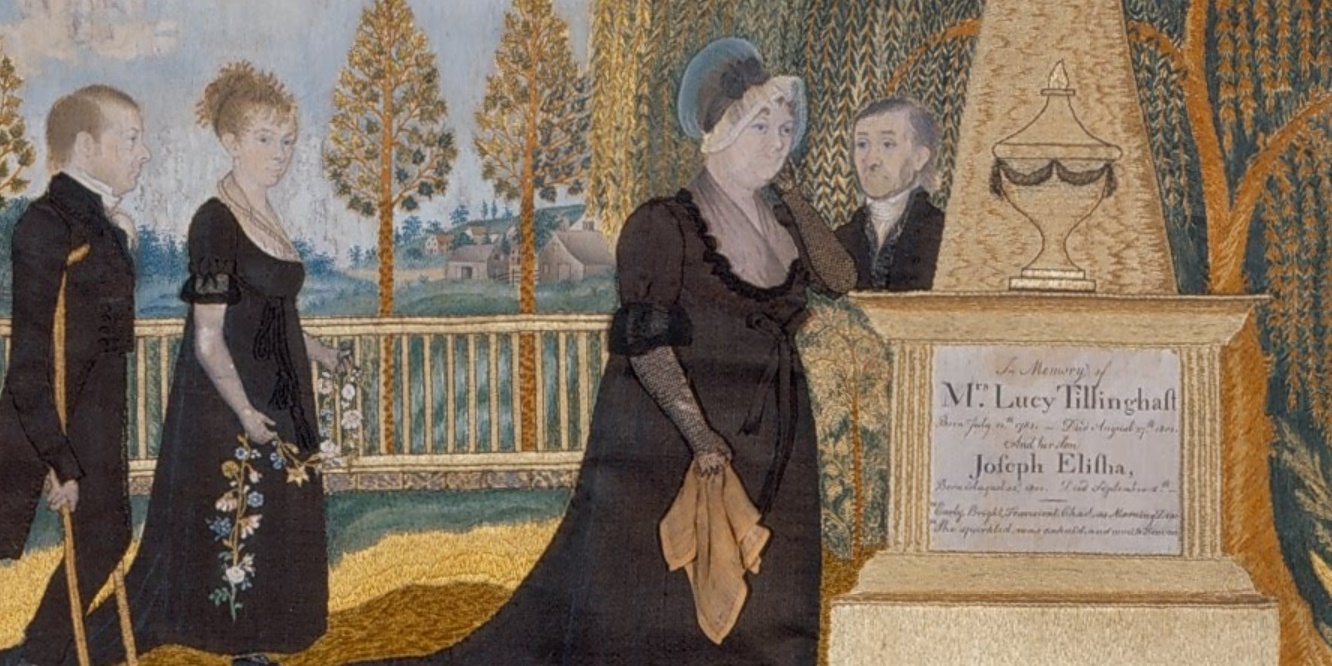
This scene is from what is called a "Mourning Sampler" - in mourning or memory of a person who had passed on -
again often containing genealogical data - it was a combination of needlework and artwork.

The blue background of this sampler makes it very rare.
Poetic verse and rhyme were often stitched onto samplers
and the "remember me" theme was a common one.
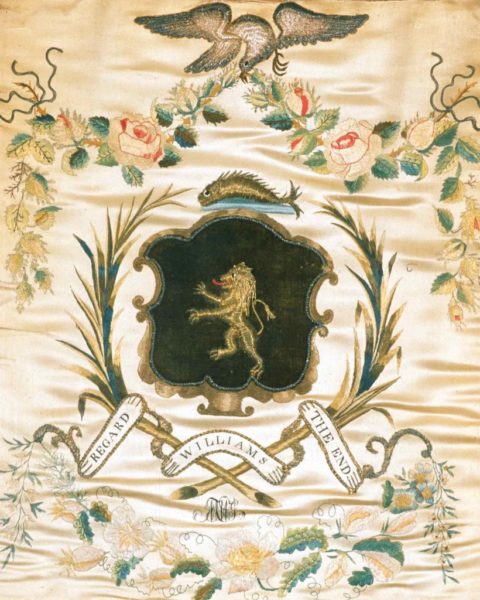
Some samplers were used to display family coat of arms.
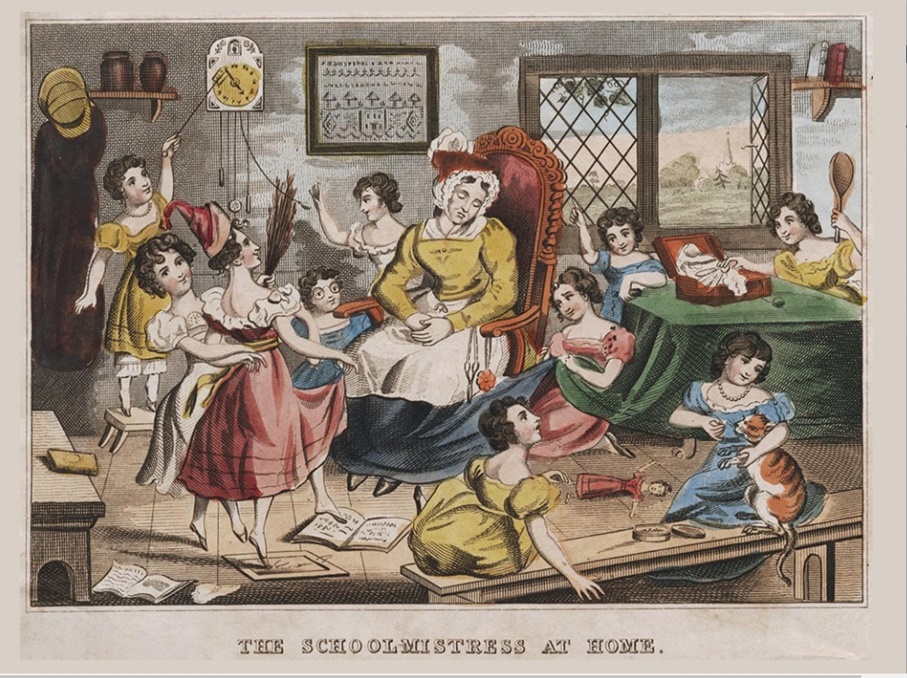
Young girls of well to do families often learned the skill of needlework by creating samplers at a special
school for young girls (ages 12-16 or so).

"To colleges and schools ye youths repair, Ye improve each precious moment while you're there."

Samplers often touched on the subject or themes of
mortality, religion, family,
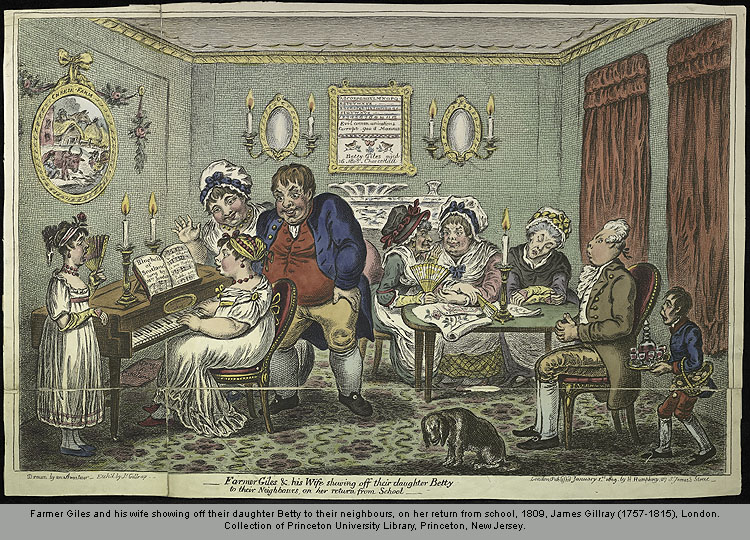
a scene from an English home where a family is "showing off" the skills and talent
of their daughter who has just returned from school - note the samplers on the wall.
Some examples of common themes in sampler verse and rhyme.
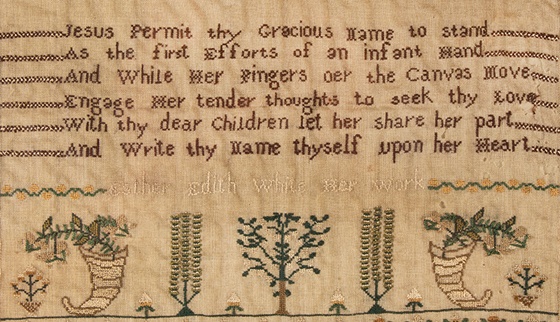
| Tho our Countrie everywhere is fil’d With ladies and with gentlewomen skil’d In this rare art, yet here they may discerne Some things to teach them if they list to learne And as this booke some cunning workes doth teach Too high for meane capacities to reache So for weake learners other workes here be As plaine and easie as an A B C. |
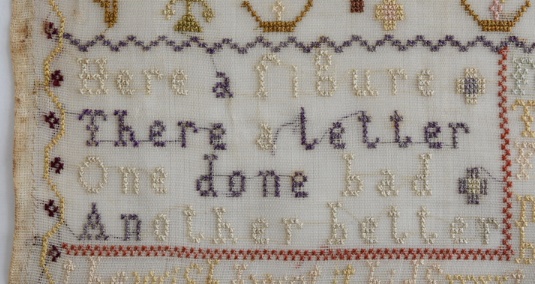
above "Here a figure, There a letter, One done bad, And another better"
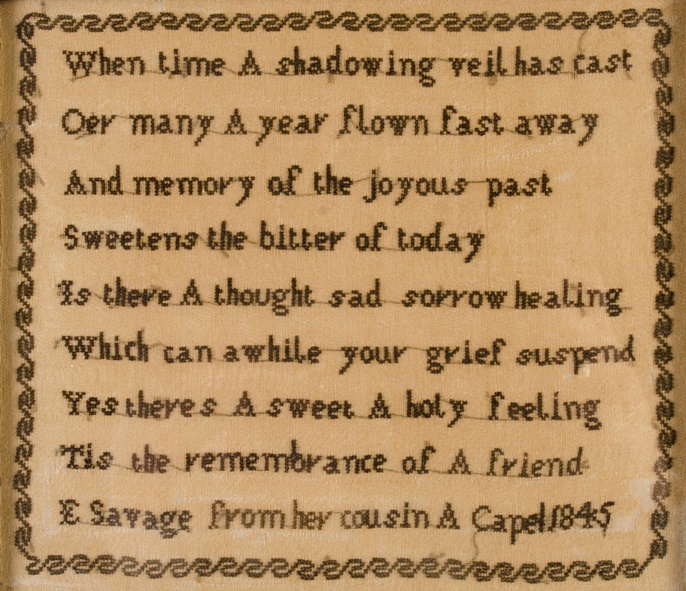
“Our father ate forbidden Fruit,
And from his glory fell;
And we his children thus were brought
To death, and near to hell.”
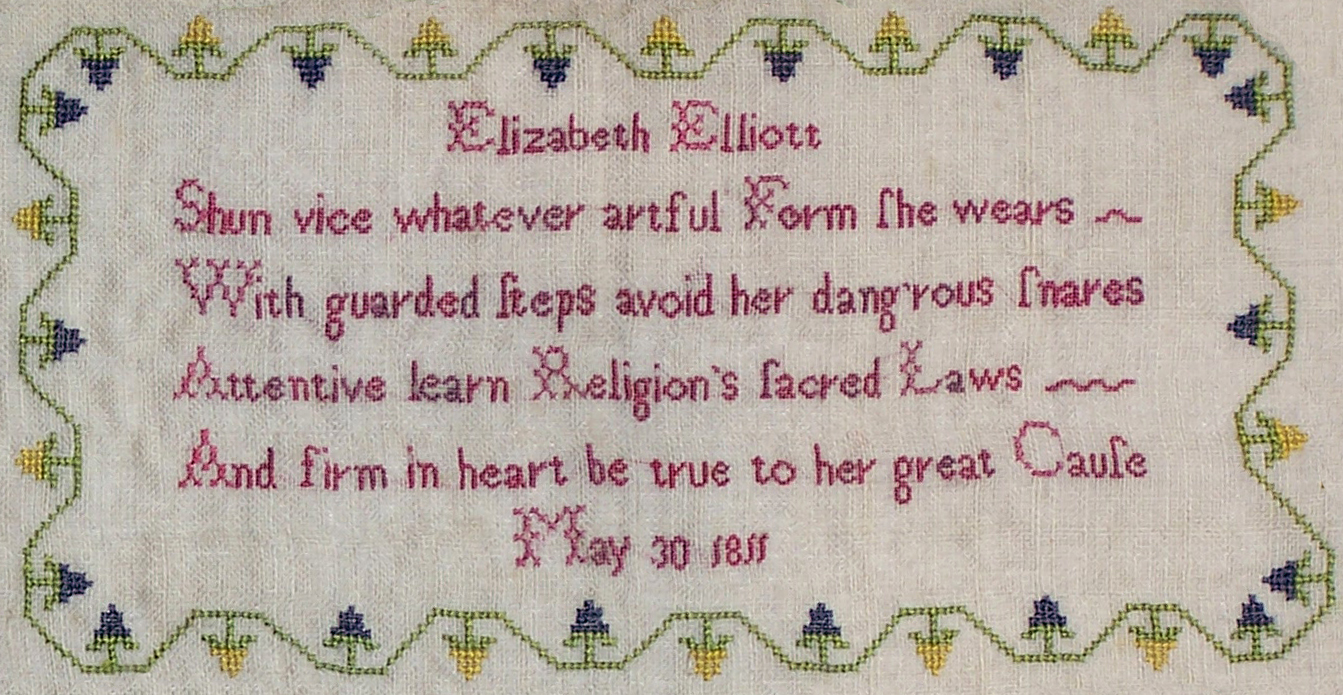
| “Sad sewers make sad samplers. We’ll be sorry Down to our fingers’-ends and ’broider emblems |

“In prosperity friends will be plenty,
But in adversity not one in twenty,”

“When this you see, remember me,
And keep me in your mind;
And be not like the weathercock
That turn att every wind.
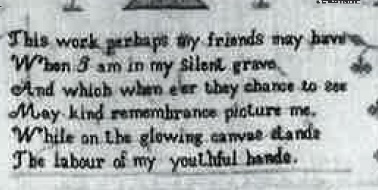
“Our life is nothing but a winters day,
Some only breake their fast, & so away,
Others stay dinner, & depart full fed,
The deeper age but sups and goes to bed.
Hee’s most in debt, that lingers out the day,
Who dyes betimes, has lesse and lesse to pay.”

“Ann Stanfer is my name
And England is my nation
Blackwall is my dwelling place
And Christ is my salvation.”
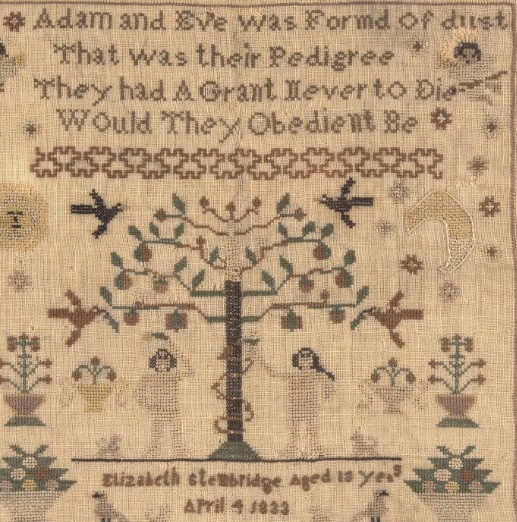
“In reading this if any faults you see
Mend them yourself and find no fault in me.”

“And now my soul another year
Of thy short life is past
I cannot long continue here
And this may be my last.”
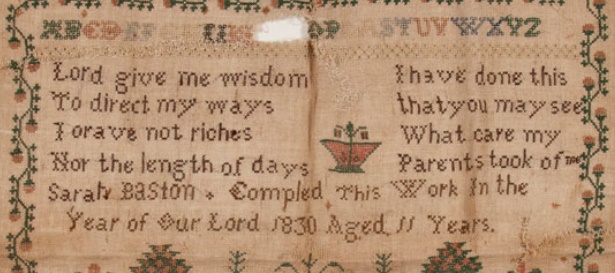
“The world’s a city full of crooked streets,
And Death’s the market-place where all men meet;
If life was merchandise that men could buy
The rich would always live, the poor alone would die.”
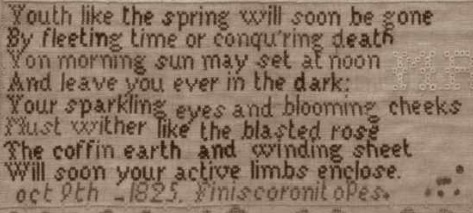
“Oh child most dear
Incline thy ear
And hearken to God’s voice.”
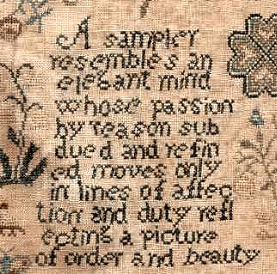
“This handy work my friends may have
When I am dead and laid in grav.”
DJY: over the past few months as I
have been able to collect digital copies of hundreds of needlework
samplers.
I have really been amazed at how complex and diverse the subject matter and perspectives on this subject are.
To many it would seem like a very dull subject to pursue - concerning the extant artifacts from young girls learning to sew and embroider about 200 years ago. But truth is I have been very surprised and taken back at just how complex and diverse this study has been and what an extremely wide range of subjects, themes and perspectives I have seen analyzed by many that are related to this seemingly simple subject. Below are just a few topics and themes that I have seen focused on by researchers - with some very interesting results from such studies.
I have really been amazed at how complex and diverse the subject matter and perspectives on this subject are.
To many it would seem like a very dull subject to pursue - concerning the extant artifacts from young girls learning to sew and embroider about 200 years ago. But truth is I have been very surprised and taken back at just how complex and diverse this study has been and what an extremely wide range of subjects, themes and perspectives I have seen analyzed by many that are related to this seemingly simple subject. Below are just a few topics and themes that I have seen focused on by researchers - with some very interesting results from such studies.
CLICK ON THE SUBJECT OF INTEREST BELOW
EARLY AMERICAN EDUCATION
RELIGION
FRIENDSHIP
POETRY
AMERICAN CULTURE
THE HOPE OF BEING REMEMBERED
SCRIPTURE
HISTORY OF SAMPLERS

GENDER ROLES
AFRICAN AMERICAN SAMPLERS
SAILORS AND SAILING
AND SOME NOT SO HAPPY SUBJECTS
DIFFICULT LIFE AS A TEENAGER - text of sampler

DEATH, DYING AND MORTALITY
LIFE IN ORPHANAGES
CHILD LABOR IN ENGLISH FACTORIES - also wikipedia
SLAVERY - ASHLEY'S SACK

SAMPLER DATABASES
Over 1,000 Samplers containing genealogical data at FamilySearch Memories

Another 1,000 Samplers

Yet another 1,000 Samplers

Yet another 1,000 Samplers

More Samplers
1stDibs
ADA Dealers
Amazon.com
American Sampler
Antiques and the Hearts
Antique Associates
Archive Grid
Art of Mourning
Baltimore Museum of Art
Barneby's
BidSquare
Bonhams
British Schools Museum
Canadian Samplers
Carol Telfor Antiques
Case Antiques
Cleveland Museum of Art
Collectors Weekly
Colonial Williamsburg
Connecticut Historical Society
Cooper Hewitt
Cumberland County Historical Society
Dartmouth Hood Museum
DAR Samplers
Delaware Valley Historic Samplers
Detroit Institute of Art
Don Olsen Antiques
Doyle
EBAY
Essamplaire
Folk Art Museum
Frances Lehman Loab Art Center
Glee Krueger
Hands Across the Sea
Hanover Historical Society
Historical Society of Carroll County
Historical Society of Pennsylvania
Hudson Valley Sampler Guild
Invaluable.com
JeffreySevans
Jeffrey Tillou Antiques
Just a Joy
Live Auctioneers
Lot-Art
Madalena
Maine Homes
Maine Memory Network
MeisterDruker
MESDA
Museum of Fine Arts - Boston
Museum of Early Southern Decorative Arts
Museums Five Colleges
Nebraska State Historical Society
NSCDA
National Museum of American History
National Trust Collections
Nantucket Historical Association
Needlework Antiques
New Hampshire Historical Society
New York Historical Society
Peggy McClard Antiques
Philadelphia Museum of Art
PicClick
Pilgrim Hall Museum
Rhode Island Historical Society
RISD
RubyLane
SaleRoom.com
Samplings - M. Finkel & Daughter
The Sampler Archive
The Sampler Consortium
Samplers from Africa
Scott Fithian
Selling Antiques
Skinner Auctions
Sotheby's
Stephen & Carol Huber collection
SwannGalleries
Tennessee Samplers
Textile Research Center
VanTassel Bauman
VAM / UK
Vatican
Witherells
Witney Antiques
WorthPoint
Antique Sanplers
ONLINE QUERIES
Google - Antique Samplers
INTERESTING ANECDOTES
An IIlegitimate Birth

OTHER LINKS
Million Dollar Sampler

Needle Pen and Social Geography . . .
GREAT REFERENCE BOOKS
- often packed with genealogical info concerning the family of sampler makers
CLICK HERE
VIDEO PRESENTATIONS
Embrodiery Exhibition
Antique Samplers
Buying Samplers
Sampler Appraisal

Question: How valuable are Needlework Samplers as it related to Genealogical Research.
Answer:
My feelings on this question have evolved over time. I
initially considered the sampler as more of a novelty item
that was interesting because it was something actually created by
someone in the past - whether they be an ancestor of my own or someone
elses ancestor. But I didnt necesarily feel that it was
something of any real siginficant genealogcial value.
With time I have come to realize just how many family samplers are out there that do contain family geneaogical data (now over 1,500 samplers of which I have colllected digital images for).
One of my initial questions that I pondered was whether the families or persons that these genealogical samplers represented would already be recorded in FamilySearch FamilyTree. In my experience so far the vast majority of American samplers do indeed have corresponding families already represented in FamilyTree. This gives some sort of vague idea as to the massive amount of people that are indeed already represented in FamilySearch Family Tree.
However, with that being said - in a significant portion of samplers I did find that there was either missing information, or entire missing members of the corresponding family in FamilyTree. Of specific focus is the fact that these samplers were made in a time and place when infant nortality was very high (as compared to today's standards). Just about any married couple with a large family would end up burying one or more of their children. The cases of couples burying more than three young children is really much more common than one would think. The truth of the matter is people who lived in earlier centuries were much much more exposed to death, mortality and suffering. Many people today view the mourning samplers as quite gloomy, dark, and despondent with an inordiante focus on death and dying and the stark reality of mortality. But when one realizes just how common death was in this era - one realizes that even for a young girl in her pre teens - such tender children were so often already very much familiar with death and dying and many just accceptd it as part of living.
So to come back to my queston as to the genealogial value of these samplers - I have found that it is not uncommon at all to see that these samplers have often recorded births and deaths that may not be recorded elsewhere - often for the reason that many of such "forgotten souls" were the victims of infant mortality. This as well as mother's dying in childbirth or due to complications was also very common.
So in summary - many of the thousands of samplers that exist - have reference to names and dates and other items of genealogical value that may not be easily found elsewhere. In a very uniqiue way these samplers made by girls of a very tender age - are now what may be re-uniting a complete family - as they exist in genealgical records and databases - bringing back into memory and record those young infants that may have been forgotten on family records.
With time I have come to realize just how many family samplers are out there that do contain family geneaogical data (now over 1,500 samplers of which I have colllected digital images for).
One of my initial questions that I pondered was whether the families or persons that these genealogical samplers represented would already be recorded in FamilySearch FamilyTree. In my experience so far the vast majority of American samplers do indeed have corresponding families already represented in FamilyTree. This gives some sort of vague idea as to the massive amount of people that are indeed already represented in FamilySearch Family Tree.
However, with that being said - in a significant portion of samplers I did find that there was either missing information, or entire missing members of the corresponding family in FamilyTree. Of specific focus is the fact that these samplers were made in a time and place when infant nortality was very high (as compared to today's standards). Just about any married couple with a large family would end up burying one or more of their children. The cases of couples burying more than three young children is really much more common than one would think. The truth of the matter is people who lived in earlier centuries were much much more exposed to death, mortality and suffering. Many people today view the mourning samplers as quite gloomy, dark, and despondent with an inordiante focus on death and dying and the stark reality of mortality. But when one realizes just how common death was in this era - one realizes that even for a young girl in her pre teens - such tender children were so often already very much familiar with death and dying and many just accceptd it as part of living.
So to come back to my queston as to the genealogial value of these samplers - I have found that it is not uncommon at all to see that these samplers have often recorded births and deaths that may not be recorded elsewhere - often for the reason that many of such "forgotten souls" were the victims of infant mortality. This as well as mother's dying in childbirth or due to complications was also very common.
So in summary - many of the thousands of samplers that exist - have reference to names and dates and other items of genealogical value that may not be easily found elsewhere. In a very uniqiue way these samplers made by girls of a very tender age - are now what may be re-uniting a complete family - as they exist in genealgical records and databases - bringing back into memory and record those young infants that may have been forgotten on family records.
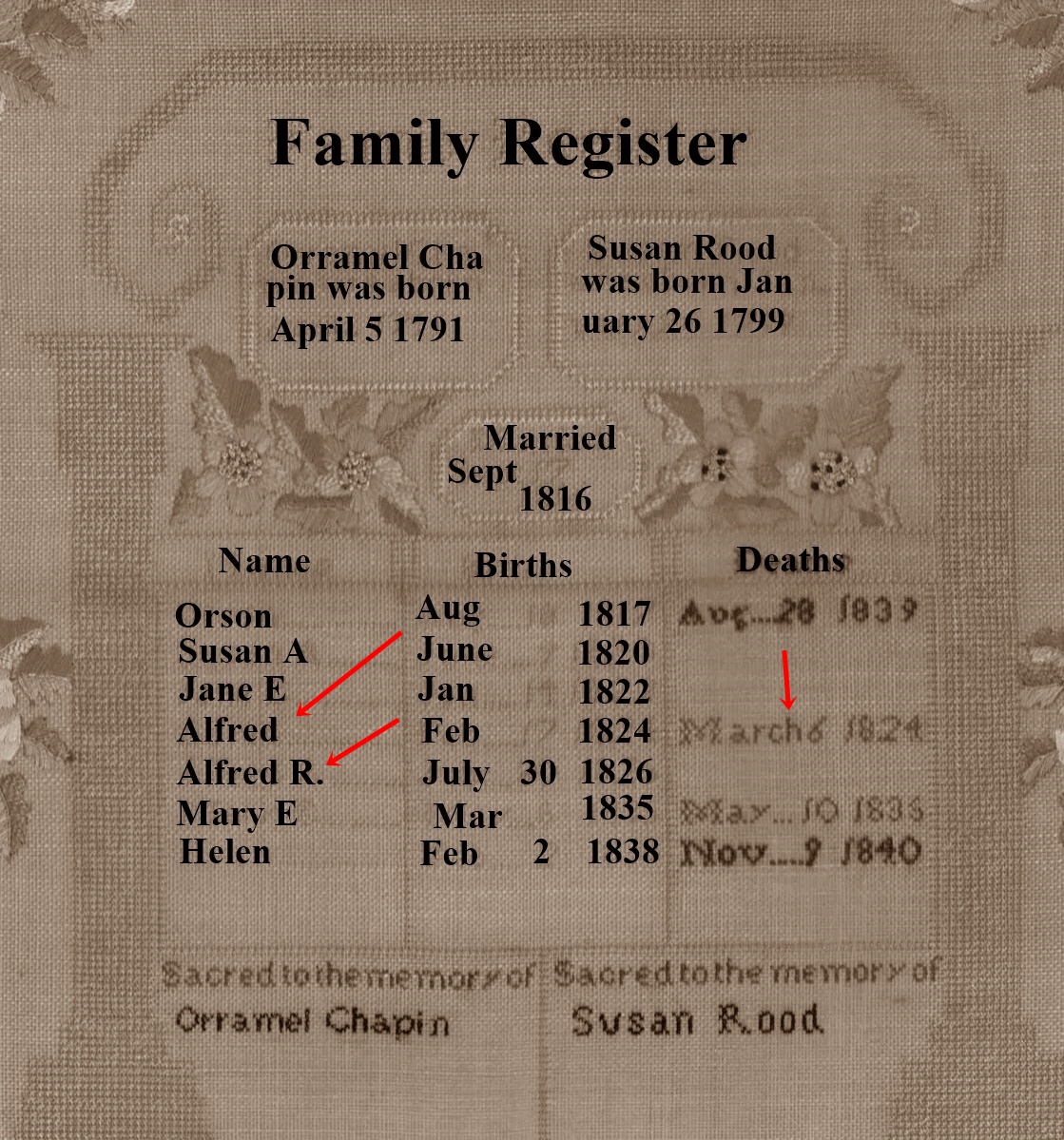
Above - A family record sampler - recording two children by the same name - one having died in infancy
and a successive child being given the same name.
Also note, below, the infant child was left out of FamilySearch FamilyTree records
Thus one can see how these family samplers are completing the family record and "re-uniting once again the close knit family"

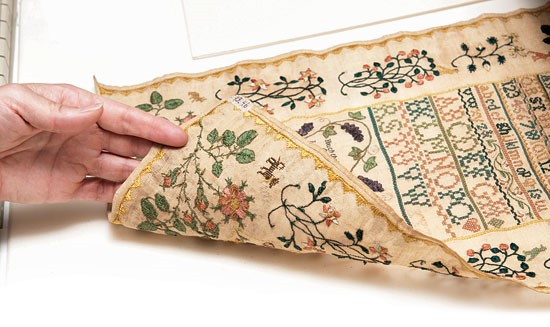
What can YOU find - as you look for family information among needlework samplers?